Farming in Romania is simple yet complex … but so is gardening. All too often it happens that the reasons why people actually get involved in agriculture gets lost. These reasons can be overshadowed by the arguments for or against industrialization, debates over genetically-modified organisms and other topics that seem more appealing or controversial. The ways in which individuals garden definitely differ but there are also obvious similarities. It may not be such a leap to start sketching out some basic profiles of gardeners not just in Romania but across Europe. Insight into this subject may provide key ways for how we expand the use of sustainable and organic food production in the future.

Research is currently being compiled on this topic by Cecile Marcus, a French student from Agrocampus Ouest – Centre de Rennes. She is working in conjunction with Eco Ruralis, a Romanian NGO that supports traditional peasant farming. Initially, she conducted interviews with many Romanian gardeners with the intention of discovering details about their usage of traditional seeds. However, during her research, she started noticing other patterns in the responses. In a short report which will be published soon, Marcus identifies specific types of gardeners and it is clear that 5 basic profiles emerge.
1: The most widely known and talked about profile is the “Back to the Countryside” gardener. Within this distinction are two groups who are alike yet slightly different. Both groups of people have moved from the city to a rural area to establish a closer connection to nature and live a simpler life that includes more quietness, fresh air and safety for themselves and their children. They have a strong desire to become more self-sufficient in terms of producing their own healthy food using traditional seeds and do so by planting large gardens. The big difference between these groups is that one lives an authentic peasant lifestyle by practicing agriculture on a full-time basis and the other has a full-time job in the countryside that does not involve agriculture but spends a lot of time gardening.
2: The “Willful Gardener but Overloaded with Work” may live in a city, town or village but works in the city. This person owns land in the countryside with a house but constantly spends a lot of time traveling between both places. These individuals find it hard to make time to garden consistently due to work obligations but do think producing their own food is a seriously important issue.
3: Passionate “City-Dweller” gardeners are an often discussed group who make good use of limited space and resources. Some urban gardeners live on the outskirts of the city and own gardens in the small yards attached to their houses. For them, gardening is more than a hobby. Those living in apartments get creative and have bunches of potted plants on their balconies or in stairwells. The thing that binds these people is their desire to produce more food but the missing link is larger access to land.
4: “Young Activist” gardeners may live in the city too but their gardening experience is usually based on an experimental basis. These people really care about what they eat and other consumer choices. They want their political views to match their actions. For them, farming is direct action.
5: The “Conscious Facilitator” tends to his or her own garden but really works hard to serve as an intermediary between seed-saving groups, NGO’s with vital public information to disseminate and relatives, friends or acquaintances. They understand that agricultural issues are critically important and want to convince people to start using traditional seeds and save them.
All 5 types of gardeners also share things in common. In the past, many had directly or indirectly been exposed to agriculture through family gardens. They want to be connected to the land in order to live more naturally without so much stress, decrease exposure to pollution and eat healthy food. They recognize that sustainable, non-industrial food production is the only way forward.
Just as businesses pinpoint their target groups, it would be beneficial for civil society actors to do the same. Finding out the interests and concerns of small-scale food producers will help us figure out how to assist them to become more self-sufficient in terms of feeding themselves and their families. Knowing how those people first became involved in agriculture will also enable us to find better ways to directly connect prospective gardeners and farmers to real-life agricultural work. Getting people to realize that there is a network that can help them is the first step. Each person doesn’t have to fit perfectly into the 5 categories above. The point is that this information could produce innovative strategies for identifying new possible food producers and thus contributing to the building of a revived small-scale agrarian movement in Romania and across Europe.





